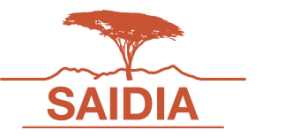In 1985, when the people of Lesirikan asked for help, it was a forgotten hamlet of six one-room shops and houses at the edge of the El Barta Plains. During the 1960s the villagers had built a health clinic with cedar offcuts they had carried on their backs from the top of the Ndoto Mountains. Twenty years later it still stood empty.
One of Lesirikan’s sons, Mohamed Lochgan, co-opted Mary Anne Fitzgerald, a journalist at the time working for the Financial Times, and Dr Kate Macintyre, a professor of public health and infectious diseases. Between them they raised sufficient funds to equip and operate a small dispensary And so SAIDIA was born. In 1988, SAIDIA built a second dispensary at Ngilai, a tiny settlement at the foot of the Mathews Range.
Working in partnership with Kenya’s Ministries of Health, the SAIDIA dispensary treated the sick and ran immunisation and health-education programs. Later, a mobile unit travelled to outlying areas to provide similar care to more remote populations that otherwise would have had to walk up to 100 km to get treatment at Lesirikan.
At the communities’ request, SAIDIA diversified into education, early-childhood development centres, water supply, environment, animal husbandry, bee-keeping, income-generation and accessing markets. Until 2014 SAIDIA was the largest health-related NGO in Samburu County, offering curative and preventive healthcare to more than 50,000 people across hundreds of square miles. With devolution came county budget lines to underwrite healthcare. SAIDIA was able to fulfil its longterm strategy of handing over health services to local government. The MoU was signed in 2017.
